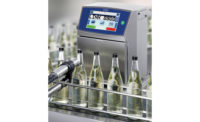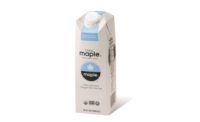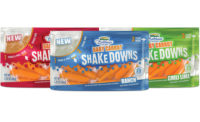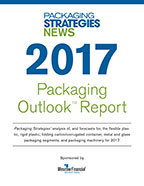From the PSNL Archives
Blast from the past: Headlines from the past 30 years in packaging

 March 31, 1986
March 31, 1986
Improvements in flexographic printing parallel growing move to flexible packaging
Flexographic printing just isn't what it used to be; it's better. And that's beginning to shake things up a little. Here's just one example: Federal Milling's “White Lily” biscuit/muffin/packaging mixes are packaged in a flexible pouch feature brilliant photos of the end product. To achieve that kind of reproductive quality, Federal naturally turned to a pricier but higher quality rotogravure process. Now they've switched to flexographic printing with what appears to be little, if any, loss of fidelity. The package construction consists of reverse printed polypropylene laminated to pouch paper with a polyethylene interior for heat sealing. There are 10 separate designs or packages in the White Lily program...
April 15, 1986
Plastics' invasion of beverage market will face resistance
PET may dominate U.S. Beverage market by 1990, but not without a fight
The adjacent chart tells you the bright side. That projection of how the beverage container market will shake out by 1990 was offered during Ryder Conference '86, March 24-26, in Atlanta, GA, by Peter Weggemen, president of Fairfield Associates. Weggeman was pitching his position that PET beverage economics favor a continued trend toward bottles manufacturing their own PET bottles.
As bottlers now take serious aim at converting smaller containers from glass to plastic and a plastic can begins to cast a giant shadow over the aluminum market, Weggeman's forecast could hold up. Although PET has a full head of steam right now, there are plenty of figurative land mines in its path. Interestingly, the most important challenge facing plastics may not come from aluminum and glass. Recycling may be the biggest hurdle of all, and there's no assurance this issue will either go away or be resolved...
November 30, 1990
Fall-out from McDonald's polystyrene ban continues to ripple through packaging
To use earthquake parlance, McDonald's decision to discontinue use of expanded polystyrene from clamshell packs, was the “big one,” the one that captured everyone's attention. Now, a lot of companies have to scramble to replace lost EPS business.
When rookies in the National Football League absorb their first certified teeth-jarring, bone-bruising tackle, they're often greeted by a grinning, toothless attacker with: “Welcome to the NFL, Rook!”
Well, folks, “Welcome to the Green Movement.” An NFL-scale tackle is what McDonald's, the mega-burger chain, delivered to the expanded polystyrene (EPS) business recently with its decision to phase out use of EPS clamshells for sandwiches...
September 15, 1991
U.S. Packaging equipment manufacturers now sell 1 out of 4 machines to international customers
In the global trade wars, the U.S. has been a net importer of packaging machinery since 1984 – thanks largely to the vigorous export efforts of German and Italian manufacturers. American packaging machinery manufacturers, however, are finding their export punch again, as 1990 equipment exports topped US$579 million – an all time record and a 19% jump over 1989's export sales. In fact, international sales now account for 23% or about 1 in 4 packaging machines build in the United States...
July, 31, 1992
12-Ounce PET bottles for soft drinks: Is it the real thing?
Is the 12-ounce PET soft drink bottle for real? Is it competing against aluminum cans or glass bottles? Is it merely a curiosity or is it the first of a new generation of PET beverage bottle sizes? Is Coke likely to follow Pepsi's lead with its own 12-ounce PET bottle?
Few soft drink packages have raised as many questions or elicited as much opinion as has the 12-ounce bottle debuted earlier this year by Buffalo Rock Co., Birmingham, AL, a franchised Pepsi bottler. Though early marketplace reaction has been positive, some are dismissing the 12-ounce PET bottle as “a gimmick” because its debut comes at a time when PET resin supply is extremely tight and beverage can prices are as low as they've been in years...
February 15, 1996
Packaging Strategies goes on-line with internet web page
Later this month, readers with access to the Internet will be able to read the latest Packaging Strategies headlines even if they're on the road and haven't seen a copy of the newsletter in three weeks. That's because as of February 21, Packaging Strategies Inc., West Chester, PA, will have a home page on the Internet's World Wide Web (WWW). The website will carry a variety of packaging news and information. Offering will be enhanced and expanded in response to feedback from site visitors. Just dial: http://www.packstrat.com...
May 31, 1996
Dole pineapple chunks, fruit cocktail debut internationally in shelf-stable plastic cups
Among the most exciting innovations in an innovation-laden Interpack '96 was the quiet debut of Dole pineapple chunks and fruit cocktail in clear shelf-stable, plastic cups with transparent flexible membrane lids...
The new plastic cup and film combination for the fruit replaces traditional three-piece steel cans. And, in a number of Asian, European and South African markets where the cups are sold, ambient shelf life is set at a remarkable one year...
January 15, 1997
Torrid M&A activity in December marked big year in transactions for packaging
A record pace of merger activity in December, 1996, closed out a year already awash in transactions. Virtually every major packaging category experience a significant realignment in market share and in the ranking of its sales leaders. All in all, 1996 was the year of the “deal.”
Right up to its last breath, 1996 was a banner year for investment bankers and attorneys. Even after our faxed news alert that Canada's Consumers Packaging and Owens-Illinois had won the battle for Anchor Glass, O-I went on to further tweak France's glass container giant, Saint-Gobain – jilted in the bidding for Anchor – by acquiring a majority of AVIR, Italy's largest glass container manufacturer...
November 15, 1997
Does stream of stand-up pouch launches portend a wave or merely a ripple?
Do the half-dozen or so stand-up pouch introductions making their way to store shelves over the next couple of months mark a sea change in the future of the stand-up pouch in the U.S.? Maybe... a lot depends on how successfully these packages connect with consumers.... The quest for product differentiations, or repositioning, is a principal trend driver, and sometimes the stand-up pouch can really deliver...
May 15, 2000
Alcoa, Reynolds Metals merger could launch a new flexible packaging giant
While the Alcan/PechineyAlgroup (known as A.P.A.) merger slammed into an antitrust roadblock in Europe, the other big aluminum industry union of Alcoa and Reynolds Metals has cleared antitrust hurdles in both the U.S. And Europe... While the transaction is seen by many as an aluminum story, the merger has plenty of potential to shake-up the flexible packaging business...
February 15, 2000
Sliced fruits lining up behind veggies as next wave in fresh-cut, packaged produce
Driven by a need for plop-in-your-mouth convenience, American consumers continue to drive demand for foods that offer little or no preparation, single-serve portions, and portability. While pre-packaged salads were once the focus of growth for flexible film manufacturers and converters, now pre-cut, sliced, peeled, and packaged fruits and vegetables such as baby carrots and sliced apples are the ones to watch...
June 30, 2001
Gerber takes baby steps toward full scale glass-to-plastic conversion
Just a year after it began test marketing its line of Gerber 2nd Foods in shelf-stable multilayer plastic containers, Gerber Products, Fremont, MI, has begun cutting its teeth nationally with its line of aseptically filled pears, applesauce, and bananas. In February of this year, Gerber rolled out nationally its line of 16 flavors of 4oz juices and yogurt-juice blends in plastic containers – making it the first U.S. Baby food producer to maker the much anticipated switch from glass to plastic on a major scale...
January 31, 2001
As cola war cools, single-serve PET juice/juice drink segment heats up
Sluggishness in the cola segments notwithstanding, the war between Coke and Pepsi is escalating on the juice/juice drinks front, with PET containers the main artillery for both. Earlier this month, Coke's Minute Maid division unveiled its 16oz single-serve orange juice in PET containers. At the same time, Pepsi rolled out its new Dole juice and juice drink line in PET bottles and 11.5oz cans. The national rollout of the Dole line – with the allied support of Pepsi's Tropicana arm – followed four months to test marketing in Florida...
August, 15, 2002
“Golden Arches” not bridging the cap for “dashboard diners”
Fast food no longer means McDonald's or Burger King. Consumers want snacks, soups and entire meals on-the-go; they want them packaged in portable, easy-to-carry and store containers; they want containers that easily fit into their cup holders in the car; they want to be able to consumer these foods with one hand while driving with the other... Major consumer food companies are answering this consumer need with their own versions of “dashboard dining.” Campbell Soup Company's Soup at Hand – a new line of ready-to-eat, single-serve soups in plastic countured containers – is an example of this trend...
August 31, 2003
Multipack: A target of opportunity on paperboard’s radar screen
Club store environs provide a fertile proving ground.
If the value of paperboard packaging shipments continues to grow at its current projected pace of 3% annually, which appears highly likely, paperboard-based multipacks should certainly be given their due as a catalyst behind that growth... Creatively designed paperboard sleeves and highly functional header cards are affording mutli-packs with multiple opportunities for unit-of-purchase variety, point-of-purchase shelf appeal, and at-home storage and dispensing convenience...
September 15, 2003
Soup giant seals the lid on can openers
If developments out of the Campbell Soup headquarters are any indication of a growing trends – and the Camden, NJ, company has more than 125 years as a symbol of Americana to support them – can openers may soon find a final resting place next to the typewriter, carbon paper, and the hand-wound watch. Just three years after rolling out easy-open pull tabs for it's ready-to-serve soups, Campbell's has converter their brand-rich red-and-white label condensed soup line to 211-diameter, easy open ends in time for the 2003-2004 soup season...
April 15, 2004
Picture Americans drinking single-serve wine?
You have to hand it to the metal can industry in the United States: after years of idly sitting on their hands while new packaging technology – and in particular rigid plastic and pouches – stole more and more of their business, can makers announced last year at PackExpo Las Vegas that they were “not going to take it anymore...” Although long consumer by modest audience in parts of Asia and the United Kingdom, the collaboration between [Ball Corp] and the Niebaum-Coppola Estate Winery, Napa Valley, CA, is believe to be the first American foray into wine in a can.
January 15, 2008
From bottled water to plastic toys, plastics packaging must manage a growing consumer backlash
Faulty science, lack of quality control, and public health issues co-mingled in 2007 to create a potent mix of production and PR problems for many plastics packaging suppliers. A healthy dose of stronger consumer marketing -- and more balanced media accounts -- could turn the tide next year but consumers remain on “orange alert” against attacks on packaging…
Consulting group Beverage Marketing Corp. (BMC) noted that the anxiety was real for bottled water last summer, when PET water growth declined, for the first time, by 1.7 percent in the United States. The move by San Francisco to ban water bottles from municipal buildings could have partly been to blame. However, bottled water growth rose in the low- to mid-teens from September to November, handing water producers a collective sigh of relief.
March 15, 2008
Nielsen study shows more than half of U.S. consumers take environment into account in packaging decisions
A new Nielsen study claims more than half of U.S. Consumers – and a higher percentage in other countries – would be willing to give up many convenience features on packaging if those packages had improved environmental benefits. The study, published Feb. 29 and the first such report done by Nielsen, is among the few that quantifies strong and still-emerging consumer interest in sustainable packaging. More than 50 percent of U.S. consumers, and nearly 60 percent of Europeans said they would give up stackability, resealability, cooking food in the package, and ease of transport if the package had added environmental features. However, the report indicates consumers were less willing to give up packaging that is more hygienic or keeps products fresher for a longer period for those packages that have added environmental benefits…
April 30, 2008
Toxic Debate: New government studies reopen health scares about bisphenol A
Though some contend scientific evidence of human health dangers to this point is scant, a mounting campaign to rid the chemical bisphenol A (BPA) from rigid plastics applications has gained new life due to government studies in the United States and Canada. According to several sources, there is growing concern among brand-owners and suppliers over a potential ban on BPA in polycarbonate (PC) food and drink applications and in epoxy resin coatings. An April 14 study from the U.S. Department of Health and Human Services’ National Toxicology Program has opened the door to more questions about BPA, while a concurrent study by the Canadian government could lead to an outright ban as a toxic chemical, sources said.
May 15, 2008
The question remains whether FTC will revise "green" marketing guidelines and curb misleading claims
The Federal Trade Commission (FTC) now must deal with some contentious issues involving sustainable packaging claims after a packed house of packaging professionals shared arguments during an April 30 hearing.About 250 people jammed into a Washington, DC, conference room April 30 (with more listening online) for an FTC public workshop on green packaging claims and consumer perceptions. The FTC is reviewing its “Guides for the Use of Environmental Marketing Claims,” unofficially called “Green Guides,” and now plans to draft new recommendations for the marketing of “so-called” sustainable packaging. More than 25 speakers offered testimony during the daylong event…
April 15, 2009
Lighter than water: PepsiCo takes the next step in industry move to take out the bottle weight
How low can they go? PepsiCo has unveiled a new water bottle under the Eco-Fina name that possesses among the lowest weight of any half-liter beverage on the market. The beverage giant has reduced the weight of its half-liter (16.9oz) bottle by 20 percent, dropping it down to 10.9 grams and radically changing the design to maintain strength and crush-resistance. The bottle itself advertises that fact: a new container obtained by Packaging Strategies from Pepsi markets the fact that it contains 50 percent less plastic than half-liter Aquafina bottles sold in 2002 and saves 75mn pounds of plastics annually…
April 30, 2009
Low Finance: Packaging industry reaches its nadir as credit crisis continues to devolve into defaults
With the financial health of packaging companies more precarious than ever, an annual report from Standard & Poor’s (S&P) contained one gem of potentially good news: perhaps the bottom has finally been reached. The New York-based ratings service showed continued alarm at the number of packaging companies near default on debt issuance or that have been downgraded in credit status due a shaky financial picture. Only two companies of the 35 rated, Crown and Silgan, received positive credit outlooks, and 26 percent of the companies were viewed by S&P as having negative ratings...
February 28, 2010
Starbuck's smells the coffee, looks into recyclable cup
Being the world’s largest and most visible coffee retailer has not been easy for Starbucks in this era of increased scrutiny for sustainability and packaging.
Indeed, Starbucks is facing up to the scrutiny. The company has announced a plan to develop a recyclable cup by 2012 and has issued a request for outside help from material suppliers, cup makers, nongovernmental organizations (NGOs), and others.
The company already has introduced a recycled-content cup sleeve. And Starbucks is calling on municipalities across the United States to adopt uniform recycling standards that allow for more thorough recycling of containers at Starbucks’ 11,000 U.S. retail locations.
May 15, 2010
Calling all cell phones: Packaging enters a new era
Packaging in North America is about to take its pose for the camera and enter a new dimension of functionality, as bar code readers move to the next stage of their rollout in retail stores. Augme Technologies, an interactive media marketing company, and barcode provider ScanBuy are launching scannable, 2D bar codes placed directly on packages, allowing higher customer interactivity with the product. Where previous iterations allowed the texting of codes on phones to download promotional rebates and rewards incentives, newer technology places a prominent bar code on a package…
May 15, 2011
Bans of polystyrene food containers continue to simmer in U.S. cities
At press time, Burlingame, CA, seemed likely to become the latest municipality to enact a ban on the use of polystyrene (PS) foodservice ware throughout the city. Following public meetings in April, a formal proposal to prohibit local businesses from selling or serving food in PS food containers was submitted to the Burlingame City Council at its May 2 meeting. The ban, which requires foodservice facilities to use eco-friendly foodservice ware that is either biodegradable, compostable, or recyclable, is expected to be adopted at the council’s next meeting on May 16 and take effect Aug. 1…
May 31, 2011
Kroger commits to banishing BPA from cans, amping up search for safe replacement
Cincinnati-based Kroger Co. announced earlier this month that it will remove the controversial plastic additive bisphenol A (BPA) from the linings of its store-brand canned goods “as quickly as possible.” As one of the top three U.S. grocery retailers, with 2,458 stores in 31 states and annual revenues topping $80bn, when Kroger makes such a move, shock waves are bound to course through the supply chain.
December 15, 2011
Biodegradability additives stir controversy
This has been a banner year in the development and\ marketing of “biodegradable” plastics. Trouble is, there’s more than a little disagreement about whether an additive can make a petroleum- or natural gas-based plastic fully biodegradable. California’s attorney general, Kamala D. Harris, is one skeptic: On Oct. 26, she filed a first-of-its-kind “greenwashing” lawsuit against additive supplier and bottle manufacturer ENSO Plastics, as well as two bottled water companies, AquaMantra and Balance, for marketing plastic water bottles as “100% biodegradable and recyclable.” The suit alleges that the claims are “false and misleading” and violate California’s environmental marketing law.
Looking for a reprint of this article?
From high-res PDFs to custom plaques, order your copy today!







